As an experienced fish keeper, I can’t help but notice the increasing fascination with keeping mantis shrimp in home aquariums. These colorful and intriguing crustaceans are undoubtedly captivating to watch, and their unique behaviors have earned them a dedicated following among aquatic enthusiasts. However, one question that often arises is what types of fish can safely coexist with these feisty predators?
As someone who genuinely enjoys helping others create harmonious underwater communities, let’s dive into this important topic together. Before we delve into specific tank mates for your mantis shrimp, it’s vital to understand their inherent nature – they’re not called ‘thumb splitters’ for anything! Mantis shrimps possess lightning-fast appendages capable of delivering powerful strikes to unsuspecting prey (or fingers).
This makes selecting compatible companions quite challenging yet not impossible. In the following few paragraphs, I’ll share valuable insights on which fish species can live in harmony alongside your beloved mantis shrimp while maintaining a balanced ecosystem within your aquarium.
- Understanding Mantis Shrimp Behavior
- Determining Aquarium Size And Conditions
- Selecting Compatible Fish Species
- 17 That Fish Can Live With Mantis Shrimp
- Monitoring Interactions And Adjusting Accordingly
- Ensuring A Balanced Aquatic Ecosystem
- Frequently Asked Questions
- Can Mantis Shrimp Coexist With Invertebrates Like Crabs, Snails, Or Coral In The Same Aquarium?
- What Specific Dietary Requirements Do Mantis Shrimp Have, And How Can I Ensure They Receive Proper Nutrition In A Shared Aquarium?
- Are There Any Unique Health Concerns Or Diseases Specific To Mantis Shrimp That I Should Be Aware Of When Introducing Them To A Community Tank?
- How Do The Color Variations Among Mantis Shrimp Species Impact Their Compatibility With Different Fish Species In A Shared Aquarium?
- How Can I Provide An Enriching Environment For Mantis Shrimp In A Shared Aquarium To Encourage Their Natural Behaviors Without Endangering Other Tank Inhabitants?
- Conclusion
Understanding Mantis Shrimp Behavior
To truly understand the dynamics of keeping fish with mantis shrimp, we must first delve into the fascinating world of mantis shrimp behavior. These captivating crustaceans are known for their incredible aggression and powerful strikes, which can easily break aquarium glass or shatter a snail’s shell.
Nevertheless, mantis shrimp possess unique communication methods that allow them to navigate their surroundings and interact with other sea creatures in ways that may surprise you. Mantis shrimp aggression is not simply random acts of violence; it serves several purposes, including hunting prey, defending territory, and even attracting mates.
To communicate effectively within their marine environment, these colorful crustaceans use complex body language such as color changes and specific postures. Additionally, they have been observed using antennal drumming – tapping their antennae against hard surfaces to produce sounds that convey information about size, strength, and intentions to potential rivals or partners.
As experienced fish keepers know, understanding your aquatic pets‘ behavior is essential when selecting suitable tankmates. With a deeper appreciation for mantis shrimp aggression and communication methods, we can make more informed decisions on what fish species might coexist peacefully alongside these formidable predators.
This knowledge will also help us create an environment where our mantis shrimp feel secure while providing enough space for other inhabitants. Let’s now explore how to determine the appropriate aquarium size and conditions for harmoniously housing both mantis shrimp and compatible fish species.
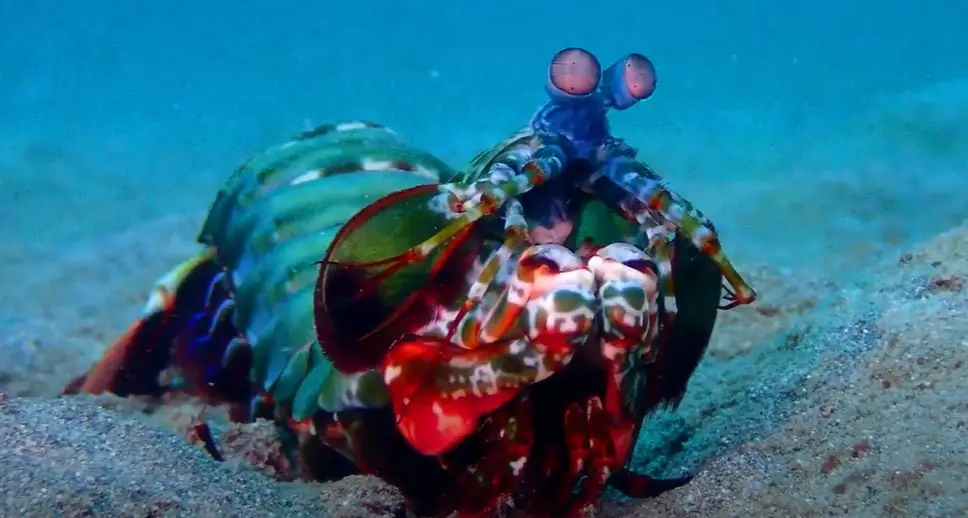
Determining Aquarium Size And Conditions
How can you create the perfect environment for your mantis shrimp and its tankmates? The answer lies in determining the right aquarium size and conditions to ensure all creatures thrive harmoniously.
First and foremost, let’s address the importance of adequate space by discussing some key considerations:
- Aquarium Size: Mantis shrimp require larger tanks than one might initially think; their predatory nature means they need ample room to hunt without causing stress among other inhabitants.
- Aquarium Maintenance: Regular cleaning is essential for aesthetic purposes, maintaining water quality, and ensuring proper filtration systems run smoothly.
- Temperature Regulation: A stable temperature range (around 72-78°F) should be maintained within the tank, as fluctuations can lead to stress or illness among mantis shrimp and potential tankmates.
It’s important to remember that even with ideal aquarium conditions, compatibility between species remains a paramount concern when building your community of aquatic life. Remember that certain fish may fare better with mantis shrimp than others due to temperament, size, or behavior differences.
With this knowledge, it becomes imperative to carefully research each prospective addition before committing them to your aquarium ecosystem.
Now that we’ve established the necessary groundwork regarding tank parameters and maintenance, we focus on selecting compatible fish species that coexist peacefully alongside your mantis shrimp. In doing so, we aim to build an underwater haven where every creature thrives while fulfilling its unique roles within this delicate microcosm.
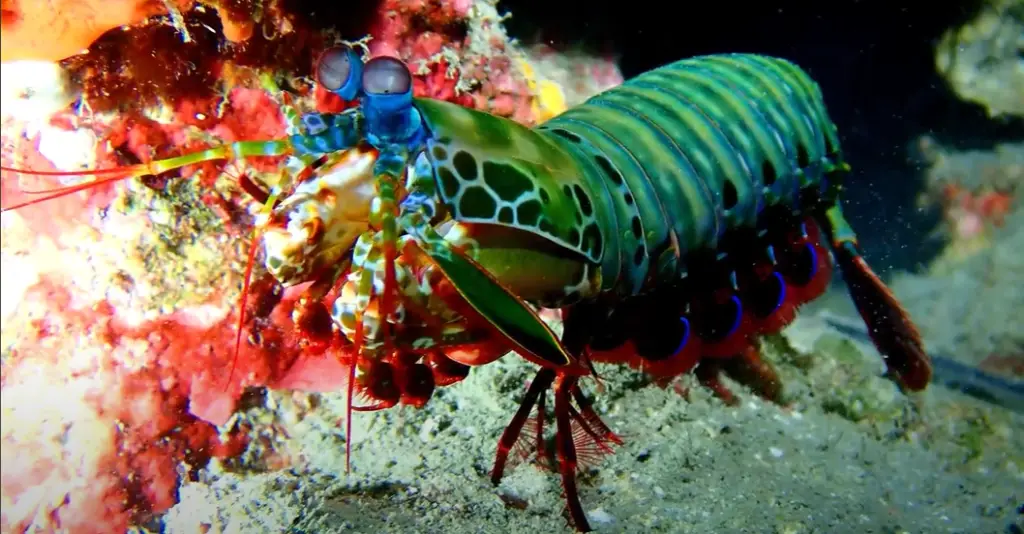
Selecting Compatible Fish Species
Selecting compatible fish species to share a tank with mantis shrimp can be challenging, but it’s not impossible.
In this quest of striking equilibrium, paying close attention to each species’ unique characteristics and behaviors becomes crucial in making informed decisions about suitable tankmates.
Regarding compatible tankmates for mantis shrimp, you must consider their aggressive nature and predatory instincts. Though they may appear captivating with their vibrant colors and fascinating behaviors, these little creatures tend to pack a powerful punch – literally!
Mantis shrimps are notorious for having one of the most potent strikes in the animal kingdom, which means some potential roomies might become dinner instead. Therefore, opting for larger or faster-moving fish species that can hold their own against these feisty crustaceans could prove beneficial during the fish selection process.
This information will help you make informed choices when selecting appropriate tankmates for your mantis shrimp. While pairing them with compatible companions is essential, there isn’t a guaranteed formula to ensure success since individual temperaments might vary even among similar species.
The key lies in observing how well they coexist over time and being prepared to intervene if necessary. This careful monitoring of interactions will enable you as an empathetic caregiver to provide optimal living conditions where everyone thrives together. After all, serving others begins by ensuring our aquatic friends live happily.
With this foundation laid out, let’s explore how best to monitor those interactions and adjust accordingly without disrupting life underwater too much.
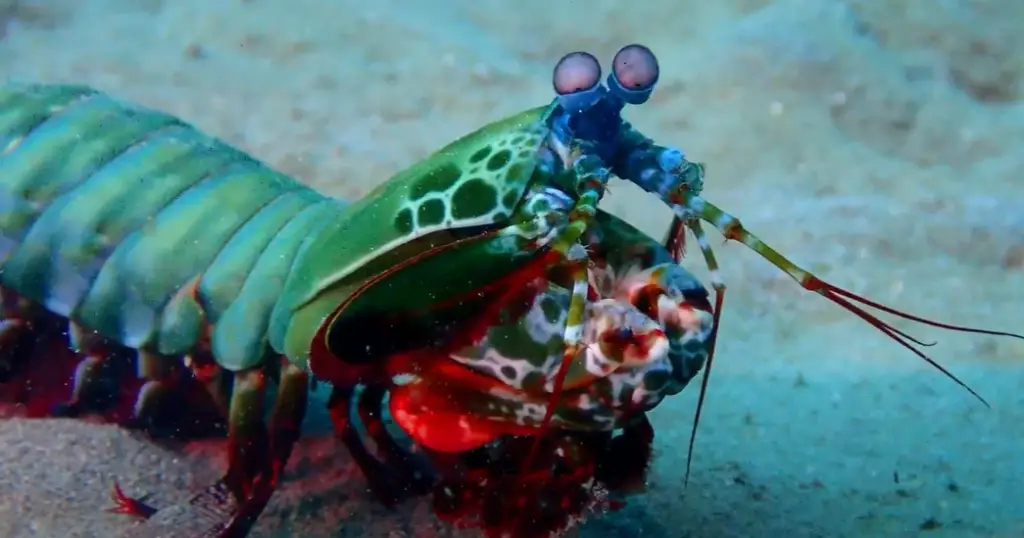
17 That Fish Can Live With Mantis Shrimp
Mantis shrimp are known to be aggressive predators and can harm other tank inhabitants, including fish. However, some fish species can coexist with mantis shrimp in the same tank. Here are some fish that can potentially live with mantis shrimp:
- Pajama cardinalfish (Sphaeramia nematoptera)
- Neon goby (Gobiosoma oceanops)
- Yellow watchman goby (Cryptocentrus cinctus)
- Fire boby (Nemateleotris magnifica)
- Royal gramma (Gramma loreto)
- Banggai cardinalfish (Pterapogon kauderni)
- Clownfish (Amphiprion spp.)
- Mandarin dragonet (Synchiropus splendidus)
- Blue-Green chromis (Chromis viridis)
- Cardinalfish (Apogon spp.)
- Pygmy angelfish (Centropyge spp.)
- Dartfish (Ptereleotris spp.)
- Hawkfish (Cirrhitichthys spp.)
- Blennies (Meiacanthus spp.)
- Jawfish (Opistognathus spp.)
- Tangs (Zebrasoma spp.)
- Filefish (Monacanthus spp.)
However, it’s important to note that there is no guarantee that these fish will be safe in a mantis shrimp tank. The mantis shrimp’s aggression and behavior can vary depending on its species, personality, and environment. It’s always best to research the specific species of mantis shrimp, and fish you’re interested in keeping together and observing their interactions closely.
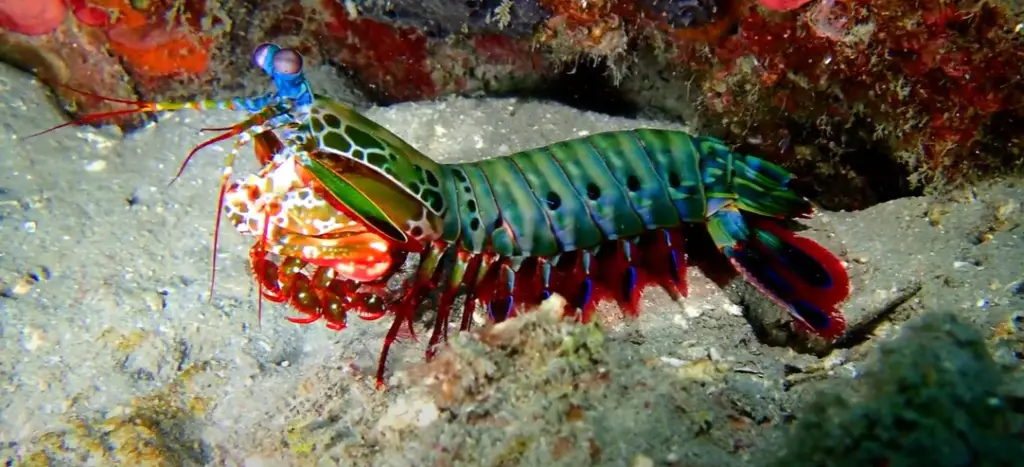
Monitoring Interactions And Adjusting Accordingly
Now that you understand the compatible fish species to pair with your mantis shrimp, it’s time to watch their interactions. Observing how they interact is crucial in ensuring peaceful coexistence and maintaining harmony within your aquarium. Remember, every creature can have a unique temperament, so close interaction observation will be key.
Introduce new tank mates gradually into the environment. Start by placing them in separate isolation tanks placed next to each other or using dividers in a shared tank. This allows both parties to get acquainted without causing immediate stress or harm. Observe their behaviors closely and look for any signs of aggression from either side before fully integrating them into the same space over time.
During this gradual introduction phase, ensure that all creatures receive proper care, nutrition, and attention – after all, we want everyone to feel comfortable and well-cared-for in their new home.
Remember that adjustments may be necessary as you continue monitoring these newfound relationships among your aquatic pets. Don’t hesitate to reevaluate if certain individuals exhibit aggressive behavior or seem stressed due to overcrowding or competition for resources such as food or hiding spots.
Keeping an open mind and being willing to adapt based on observations can help ensure long-term success and happiness for all inhabitants of your underwater world. With careful planning and attentive management, you’re well on your way towards creating a thriving community while considering the needs of each member — humanely putting together a balanced aquatic ecosystem awaits in our next discussion!
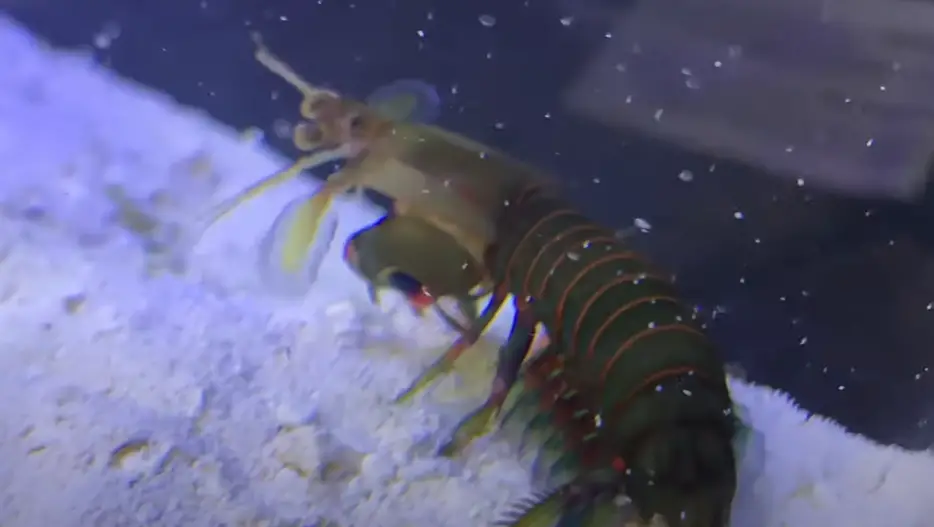
Ensuring A Balanced Aquatic Ecosystem
Creating a balanced aquatic ecosystem is like conducting an underwater symphony, with each fish playing its part in maintaining harmony.
You’ve probably faced the challenge of finding suitable tank mates for your mantis shrimp. It’s crucial to understand that not all species can coexist peacefully; hence, ensuring predator-prey balance within your aquarium is essential.
To achieve ecosystem harmony, consider introducing other marine creatures like cleaner shrimps and crabs that serve as natural prey for your mantis shrimp. Since these critters are adept at hiding from predators, they will provide enough stimulation without overwhelming their hunter. Another option is including passive fish such as tangs or gobies that can easily evade the swift strikes of the mantis shrimp while serving others by controlling algae growth in the tank.
One last word of advice: don’t forget to monitor the interactions between your aquatic inhabitants regularly to ensure a harmonious environment where everyone has a role in serving one another. Keep an eye on population control and be prepared to adjust accordingly if any imbalances arise.
Doing so will create a thriving underwater haven where every creature plays its part in preserving equilibrium and nurturing life beneath the waves.
Frequently Asked Questions
Can Mantis Shrimp Coexist With Invertebrates Like Crabs, Snails, Or Coral In The Same Aquarium?
Invertebrate compatibility with mantis shrimp is often challenging, as these fascinating creatures are known for their aggression and predatory behavior.
I’ve observed that most invertebrates like crabs, snails, or corals might face trouble coexisting with a mantis shrimp in the same aquarium. Their powerful claws can easily crack shells and damage delicate coral structures.
However, there’s something incredibly rewarding about providing a safe environment where all species can thrive together despite their distinct behaviors. So if you’re passionate about serving others – including your aquatic pets – it’s essential to carefully research each species’ requirements and consider setting up separate tanks to ensure everyone flourishes without harm.
I can’t stress enough the importance of understanding your mantis shrimp’s dietary needs to keep their aggression in check and facilitate shrimp communication in a shared aquarium.
These fascinating predators require a varied diet consisting primarily of live or frozen meaty foods, such as small fish, crustaceans, and mollusks.
To ensure they receive proper nutrition while coexisting with tank mates, consider providing them with feeder shrimp or ghost shrimp and using feeding tongs for targeted feedings.
By catering to their carnivorous cravings, you’ll promote their overall well-being and contribute to a harmonious aquatic community where every inhabitant thrives.
Are There Any Unique Health Concerns Or Diseases Specific To Mantis Shrimp That I Should Be Aware Of When Introducing Them To A Community Tank?
When introducing mantis shrimp to a community tank, it’s essential to be aware of potential health concerns and diseases specific to these fascinating creatures.
Mantis stress can significantly affect disease prevention, as stressed individuals are more susceptible to various infections and illnesses.
It’s vital for us fish enthusiasts who love lending nature a helping hand to maintain excellent water quality, provide an appropriate diet, and ensure their living environment is tailored to their needs (including hiding spots and space).
By doing so, we create the ideal conditions for the well-being of our mantis shrimp and all other residents in our aquatic community.
Did you know that mantis shrimp are known to have one of the most complex visual systems in the animal kingdom?
This fascinating attribute intrigues color compatibility and interspecies interactions when considering adding them to a shared aquarium.
Generally, their vibrant colors don’t cause significant issues with other fish species; however, watching how different hues may affect the overall dynamics within your aquatic community is essential.
I recommend carefully observing any changes in behavior or stress levels among tank inhabitants after introducing these captivating crustaceans into your underwater haven.
Ultimately, creating harmony amongst diverse marine life contributes to a healthier ecosystem and serves as a testament to our commitment to nurturing and preserving nature’s beauty.

Creating an enriching environment for mantis shrimp in a shared aquarium requires understanding their unique personalities and considering tank size considerations.
I recommend offering plenty of hiding spots and visual barriers to allow your mantis shrimp to exhibit natural behaviors without threatening other tank inhabitants.
Choose sturdy structures like live rock formations, PVC pipes, or ceramic caves that can withstand the powerful strikes from their ‘smasher’ appendages.
Additionally, ensure you have a larger-sized aquarium (ideally 30 gallons or more) so there’s ample space for the mantis shrimp and its tankmates to thrive harmoniously.
Remember, balancing satisfying our underwater friends’ needs and keeping them safe, and coexisting is key; it ultimately serves our common goal – creating a thriving aquatic community, we can all enjoy!
Conclusion
Creating a harmonious underwater haven for your mantis shrimp and their aquatic companions can be challenging and rewarding.
You’ll need to carefully consider each species’ needs and quirks while expertly balancing the delicate ecosystem of your shared aquarium.
So dive into this vibrant world of marine camaraderie and witness the mesmerizing dance of colors as your mantis shrimp coexists with its tank mates.
Patience, research, and keen observation are key ingredients in achieving this aquatic utopia!
